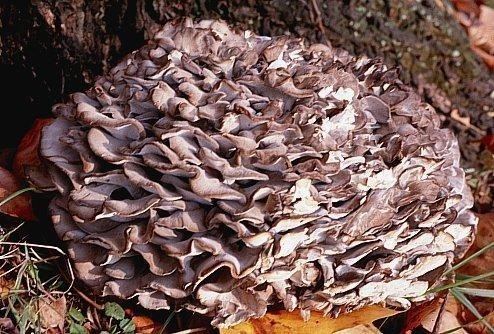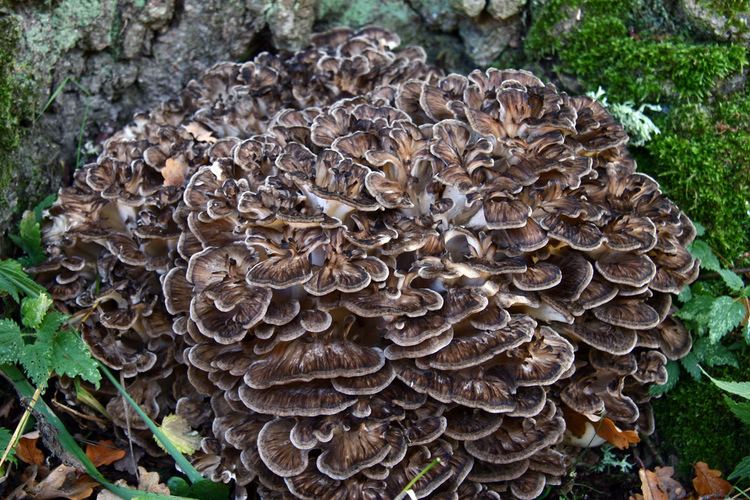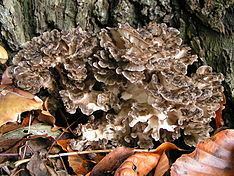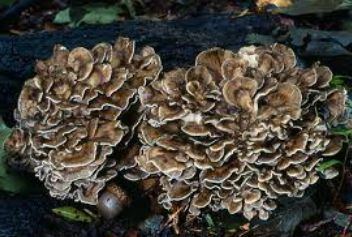Kingdom Fungi Class Agaricomycetes | Division Basidiomycota | |
 | ||
Similar Shimeji, Shiitake, Lingzhi mushroom, Enokitake, Pleurotus eryngii | ||
Grifola frondosa is a polypore mushroom that grows in clusters at the base of trees, particularly oaks. The mushroom is commonly known among English speakers as hen of the woods, hen-of-the-woods, ram's head and sheep's head. It is typically found in late summer to early autumn. In the United States' supplement market, as well as in Asian grocery stores, the mushroom is known by its Japanese name maitake (舞茸, "dancing mushroom"). Throughout Italian American communities in the northeastern United States, it is commonly known as the signorina mushroom. G. frondosa should not be confused with Laetiporus sulphureus, another edible bracket fungus that is commonly called chicken of the woods or "sulphur shelf". Like all polypores, the fungus becomes inedible when older, because it is then too tough to eat.
Contents
The fungus is native to the northeastern part of Japan and North America, and is prized in traditional Chinese and Japanese herbology as a medicinal mushroom. It is widely eaten in Japan, and its popularity in western cuisine is growing, although the mushroom has been reported to cause allergic reactions in rare cases.

Description

Like the sulphur shelf mushroom, G. frondosa is a perennial fungus that often grows in the same place for a number of years in succession. It occurs most prolifically in the northeastern regions of the United States, but has been found as far west as Idaho.

G. frondosa grows from an underground tuber-like structure known as a sclerotium, about the size of a potato. The fruiting body, occurring as large as 100 cm, is a cluster consisting of multiple grayish-brown caps which are often curled or spoon-shaped, with wavy margins and 2–7 cm broad. The undersurface of each cap bears approximately one to three pores per millimeter, with the tubes rarely deeper than 3 mm. The milky-white stipe (stalk) has a branchy structure and becomes tough as the mushroom matures.

In Japan, the Maitake can grow to more than 100 pounds (45 kg), earning this giant mushroom the title "King of Mushrooms". Maitake is one of the major culinary mushrooms used in Japan, the others being shiitake, shimeji and enoki. They are used in a wide variety of dishes, often being a key ingredient in nabemono or cooked in foil with butter.
Medical research and use

In 2009, a phase I/II human trial, conducted by Memorial Sloan–Kettering Cancer Center, showed Maitake could stimulate the immune systems of breast cancer patients. Small experiments with human cancer patients have shown Maitake can stimulate immune system cells, like NK cells. In vitro research has also shown Maitake can stimulate immune system cells. An in vivo experiment showed that Maitake could stimulate both the innate immune system and adaptive immune system.
In vitro research has shown Maitake can induce apoptosis in various cancer cell lines as well as inhibit the growth of various types of cancer cells. Small studies with human cancer patients revealed that a portion of the Maitake mushroom, known as the Maitake D-fraction, possesses anti-cancer activity. In vitro research demonstrated the mushroom has potential anti-metastatic properties.
Research has shown Maitake has a hypoglycemic effect, and may be beneficial for the management of diabetes. The reason Maitake lowers blood sugar is because the mushroom naturally contains an alpha glucosidase inhibitor.
Maitake contains antioxidants and may partially inhibit the enzyme cyclooxygenase. An experiment showed that an extract of Maitake inhibited angiogenesis via inhibition of the vascular endothelial growth factor (VEGF).
Lys-N is a unique protease found in Maitake. Lys-N is used for proteomics experiments because of its protein cleavage specificity.
